
Stetsonia coryne, the toothpick cactus, is the sole species in the cactus genus Stetsonia. Stetsonia coryne grows to a height of 15 to 25 ft tall. It has white flowers.

Harrisia is a genus of night blooming cacti.
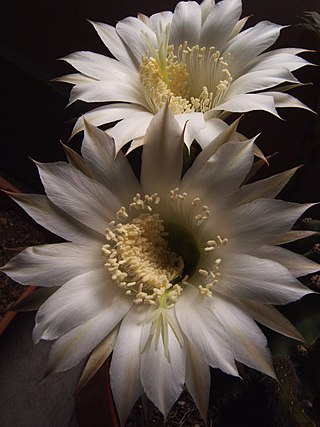
Echinopsis oxygona also known as Eyries cactus, Easter lily cactus or sea-urchin cactus is a species of flowering plant in the cactus family Cactaceae, native to South Brazil, Uruguay and northern Argentina. Its features include many robust spines, spherical shape, and a large flower, with sharply pointed lavender or white petals, and a fine faint scent.

Ariocarpus agavoides is a species of cactus. It is endemic to Mexico. It grows in dry shrubland in rocky calcareous substrates. Some taxonomists place it in a separate genus as Neogomezia agavoides. The locals use the slime from the roots of the plants as glue to repair pottery. The sweet-tasting warts are eaten and often added to salads
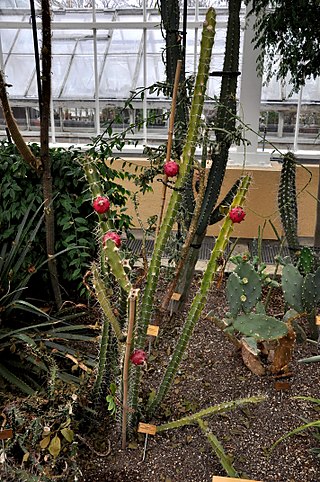
Harrisia bonplandii is a species of cactus. The cactus plants in the Gran Chaco are generally called tuna and this specific variety reina de la noche. Fruits and roots are edible and well known to the native nations of the Gran Chaco.
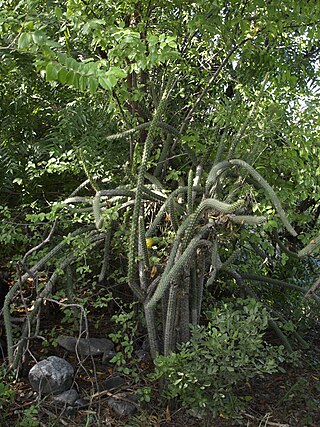
Harrisia divaricata is a species of cactus endemic to Hispaniola.
Harrisia gracilis is a species of cactus found in Jamaica.

Harrisia fragrans is a rare species of cactus known by the common name fragrant prickly apple. It is endemic to Florida, where it is known only from St. Lucie County. The plant's habitat has been almost completely consumed by development, leading to its rarity. It is a federally listed endangered species of the United States.

Harrisia martinii, commonly called the Martin applecactus, is a species of night-blooming, rope-like cacti native to South America. With large showy flowers that attract the hawk moth, it is considered by some a useful landscape plant in areas that do not freeze.
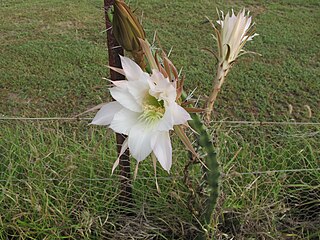
Harrisia pomanensis is a species of cactus.
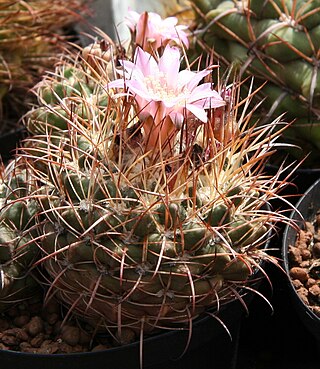
Neowerdermannia vorwerkii, also known as achakana, is a species of cactus from high altitudes in Bolivia and northern Argentina.

Gymnocalycium oenanthemum is a species of flowering plant in the family Cactaceae, endemic to Argentina. A slightly flattened sphere growing to 12 cm (4.7 in), it has 10-13 ribs, each containing a row of tubercles with radial spines. In summer it bears a wine-red or pink daisy-like flower.

Parodia ottonis, also known as Indian head cactus, is a cactus found in Argentina, Brazil, Paraguay and Uruguay. There are two recognized subspecies. The epithet ottonis honors the German botanist Christoph Friedrich Otto.

Harrisia tortuosa is a species of cactus in the Trichocereeae tribe.

Cereus aethiops is a species of cactus found from Uruguay to Argentina.

Gymnocalycium monvillei is a species of Gymnocalycium from Argentina.

Oreocereus trollii, commonly known as the Old Man of the Andes cactus, is a species of cacti native to Argentina and Bolivia. Though listed as Least Concern by the IUCN, the plant is collected extensively, and in some areas is threatened.

Soehrensia huascha, is a species of Soehrensia in the Cactaceae family, found in north western Argentina. First published in Cactaceae Syst. Init. 29: 5 in 2013.

Harrisia tetracantha is a species of cactus found in Bolivia.

Harrisia eriophora is a species of cactus found in Cuba.



















